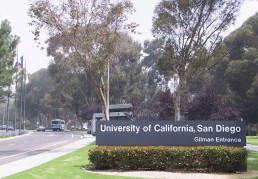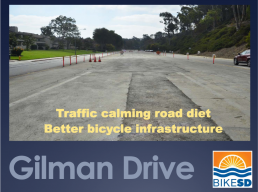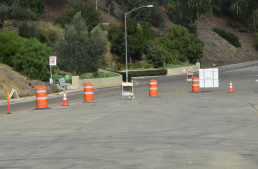Mobility Board Votes to Support Gilman Drive Segment of Coastal Rail Trail
The City of San Diego Mobility Board voted to approve the Gilman Drive Segment of the Coastal Rail Trail. The Coastal Rail Trail will connect Oceanside to Downtown San Diego, and the Gilman Drive section will more immediately connect UC San Diego to the almost completed Rose Creek Bike Path (which is being built by SANDAG as part of the Early Action program). The project will be implemented as a protected cycletrack (class IV) on both sides of the road from the I-5 interchange to La Jolla Village Drive. A dedicated bike traffic light and signal phase will also be added southbound at the entrance to I-5. Additionally, the gaps in the sidewalk on the west side of Gilman Drive will be filled in and a sidewalk will be added underneath the interchange with La Jolla Village Drive (where many students who live nearby have already created desire paths and are forced to play frogger with cars).
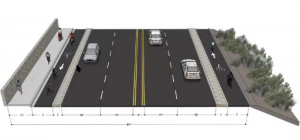
BikeSD is glad to see a protected cycletrack implemented. Not only is the current unprotected bike lane very narrow immediately north of the I-5 freeway interchange, it is made narrower by overgrown shrubbery from the canyon to the east. Combined with the curvature of the road as well as a 50mph speed limit, Gilman Drive as-is is a collision in the making. According to data from the Statewide Integrated Traffic Records System (SWITRS), there have been 15 reported bike rider collisions along the portion of Gilman Drive that will be renovated, from 2009 to 2019. Of course, many collisions also go unreported.
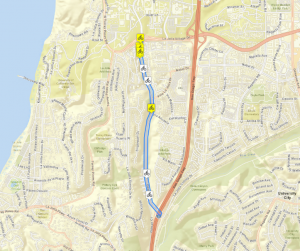
That being said, BikeSD has some reservations about the project. The project's estimated cost, $22 milion, is astronomical, and is due to the insistence of maintaining 12 foot travel lanes & a 50mph speed limit and adjacent street parking, as well as building retaining walls and working with sensitive lands. A much more affordable tactical project could have been completed with a road diet, particularly considering the lack of congestion on Gilman Drive, little parking demand south of Via Alicante, and the opening of the Mid-Coast Trolley Extension of the MTS Blue Line, which will reduce road demand even further.
Despite our reservations, this will be an important connection that will encourage even more San Diegans who are "interested but concerned" about biking to ditch their cars and help San Diego reach its Climate Action Plan goals of getting 18% of commuters to go by bike. While the project is still only partially funded, construction is anticipated to begin in Fall 2021. You can see the Mobility Board's discussion of this agenda item and the presentation by city staff via this link: Youtube
EDIT: A previous version of this article reported 11 bike rider involved collisions along the relevant section of Gilman Drive.That has been corrected to 15. The generated report can be found here.
Letter on new UCSD campus policy on micromobility devices
Dear Vice Chancellor Matthews,
We appreciate the opportunity to provide feedback on UCSD’s proposed campus policy on the use of micromobility devices, announced on November 5, 2019 [1]. The policy would establish several new rules and regulations regarding the operation of scooters, bicycles, and other small devices on UCSD campus. The need to create a safe environment for all members of the campus community and UCSD visitors is clear: with expected growth reaching 65,000-plus students, staff and faculty, getting into and around campus will be increasing complex. This policy represents an important opportunity to set expectations of campus users — through commonsense stipulations such as being able to operate safely under different conditions and yielding right of way to pedestrians — but could be expanded to help address many underlying issues that result in conflicts on a daily basis.
First, well-recognized principles of urban infrastructure design inform us that providing safe facilities where people want to walk and ride is vastly more effective and equitable than outlawing and diverting these modes [2]. Modern urban transportation plans thus aim to provide balance among the various uses of public roadways, and in particular separate traffic moving at vastly different speeds, such as through the use of off-street paths and protected bicycle lanes. Currently, UCSD campus facilities do not provide a level of ease of circulation for people regardless of whether they are walking, riding or biking. Most destinations are not connected by bike paths where riders can avoid mingling with pedestrians, and main desire lines either prohibit riding or are shared use without any signed or designated areas for riders. Construction activity throughout campus is not fully mitigated, leaving narrower and less convenient paths for everyone. We therefore urge the administration to adopt proactive infrastructural approaches to provide physical and/or marked separation between pedestrian and micromobility modes on campus, facilitating all desire lines.
Second, due to the sprawling footprint of campus, entry points via public transit are far from many campus destinations. While parking is a perennial complaint, it remains the case that most buildings have parking options within five minutes walk, while bus stops of high-volume routes can be 15 or more minutes away. As the growing community opts to take public transit, using micromobility to and from these entry points will be increasingly attractive, adding to the complexities with enforcing restrictions on their use. The trolley extension will only intensity this conflict: the nearest stop to The Village dormitory, Pepper Canyon, will be more than 25 minutes away. We propose that safe and convenient paths for micromobility are established from all existing and future transit entry points to all major campus destinations, taking advantage of both perimeter and throughcampus routes.
Finally, major roads surrounding campus for the most part lack adequate facilities for micromobility users. Genesee Ave, Gilman Drive, and N. Torrey Pines Road, among others, have dangerous, unprotected lanes next to fast-moving traffic. The UTC area, where a large fraction of off-campus students live, is only two miles from campus and yet lacks safe routes to get to class. In spite of these drawbacks, the University community sees rates of bicycle use over two times the city and county of San Diego [2]. This need must be met with sustained support and encouragement for people to leave their cars at home when commuting to campus. Best practice for roads with speeds regularly exceeding 25 mph and 6000 cars per day is to establish protected bicycle lanes with vertical barriers or raised elevation from motor vehicle traffic [3]. We urge UCSD to work with the City of San Diego and SANDAG to create safe, protected micromobility routes for all ages and abilities to all destinations within at least two miles of campus.
Let us reiterate that we strongly support ensuring the safety of all people traveling around campus. We believe this can be done in a non-punitive manner that creates and reinforces a welcoming environment for everyone to commute to and around campus via a range of alternative transportation modes. We look forward to working with you to achieve this vision.
Sincerely,
Michael Davidson, Assistant Professor, UC San Diego
Paul Jamason, IT Services, UC San Diego; Board Member, BikeSD
On behalf of BikeSD, an independent, non-governmental, nonprofit advocacy organization. Our mission: To establish San Diego as a world-class bicycling city and create a more livable urban community by promoting everyday riding and advocating for bicycling infrastructure. https://bikesd.org/
References
[1]: “Proposed Addition to UC San Diego Policy and Procedure Manual (PPM).” November 2019. UC San Diego. http://adminrecords.ucsd.edu/ppm/micromobility.html
[2]: Toole, Jennifer, & Bettina Zimny. “Transportation Planning Handbook, Ch. 16: Bicycle and Pedestrian Facilities.” Federal Highway Administration, US Department of Transportation, Washington, DC. https://nacto.org/wp-content/uploads/2011/03/Transportation-Planning-Handbook-Bicycle-and-Pedestrian-Facilities.pdf
[3]: University Community Plan Update: Existing Conditions Summary. April 2018. City of San Diego. https://www.sandiego.gov/sites/default/files/final_university_cpu_ecr_report.pdf
[4]: Designing for All Ages & Abilities: Contextual Guidance for High-Comfort Bicycle Facilities. December 2017. National Association of City Transportation Officials. https://nacto.org/wpcontent/uploads/2017/12/NACTO_Designing-for-All-Ages-Abilities.pdf
Gilman Drive (La Jolla) buffered bike lane update

A four-lane road, Gilman Drive in La Jolla near the Univ. of California San Diego (UCSD), recently had new sewer lines installed. A stretch of this newly-repaved road was mere weeks away from getting re-striped when BikeSD mobilized to have the speed limit reduced and buffered bike lanes added.
BikeSD Executive Director Judi Tentor quickly assembled a Powerpoint and made a presentation to the University City Planning Group (UCPG) to show the many ways a road diet would improve the Gilman Drive corridor for all users. The Planning Group was enthusiastic about everything in Judi's presentation, though UCSD felt it could only contribute improved lane striping (in the form of buffered bike lanes rather than a full lane/parking removal as part of their sewer line replacement.) Still, it was the most suppportive community planning group reaction Judi ever attended.
After the presentation at UCPG, BikeSD received tentative support for a change of striping from staff at UCSD. So BikeSD worked with San Diego city staff engineer Brian Genovese to get revised striping plans for Gilman Drive that include new buffered bike lanes. These drawings were completed in early December and sent to UCSD for use in the university's Gilman Drive re-striping coming later this month. BikeSD and all the UC area cyclists are hopeful about seeing this improved striping get used when UCSD closes up the sewer line project.
What remains, however, is a full set of safety improvements for bikes and scooters along the Gilman Dr corridor. In principle, UCSD says it supports narrowing the lanes, reducing traffic speeds, and a fully protected bike facility along Gilman Drive. It will be interesting to see whether this will translate to future UCSD explicit calls for making the most of this corridor. BikeSD looks forward to partnering with UCSD, the UCPG, and CalTrans in expanding safety and access for all users along the entire Gilman Dr. corridor.
Gilman Drive bike facility (La Jolla)
BikeSD Executive Director Judi Tentor will be speaking at the University Community's Plan Update Subcommittee in an effort to get striping done in the Gilman Dr. Sewer Line Replacement segment to create an enhanced bicycle facility. Meeting starts at 6pm on November 13, 2018. Judi is on the agenda at 8pm. Location: Alexandria Building, 10300 Campus Pointe Dr., 2nd floor, La Jolla.
Photos from the Flickr series here: https://www.flickr.com/photos/bicycle_dreaming/sets/72157697610916390


